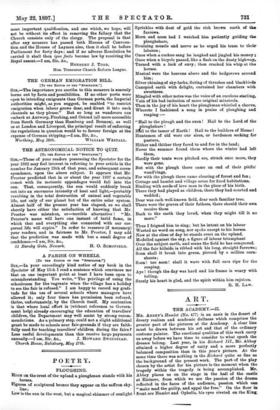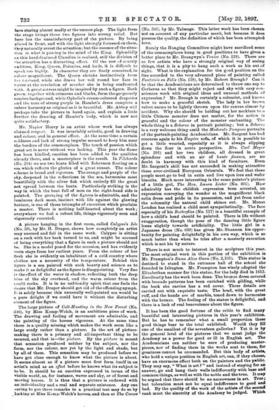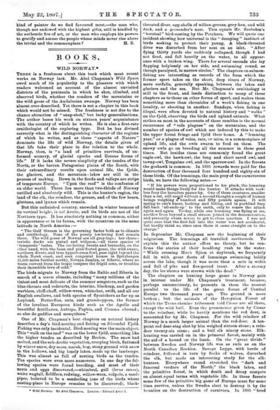ART.
THE ACADEMY.—LL
MR. ABBEY'S Hamlet (No. 477) is an oasis in the desert of dreary realism and academic dullness which comprises the greater part of the pictures at the Academy. A clear line must be drawn between his art and that of the ordinary costume painter. The emotional qualities of this work carry us away before we have time to consider to what epoch the dresses belong. Last year, in his Richard III., Mr. Abbey attained a higher degree of unity and a more perfectly balanced composition than in this year's picture. At the same time there was nothing in the Richard quite so fine as the background of the present work. The part of the play chosen by the artist for his picture is the moment when the tragedy within the tragedy is being accomplished. Mr. Abbey places us on the stage in the hall of the castle at Elsinore, from which we see the passion of the drama reflected in the faces of the audience, passion which can "make mad the guilty, and appal the free." On the floor in front are Hamlet and Ophelia, his eyes riveted on the King, hers staring almost madly at the unseen play. The light from the stage brings these two figures into strong relief. But here lies the unsatisfactory part of the picture. By being placed in front, and with the light strongly focussed on them, they naturally arrest the attention ; but the essence of the situa- tion is what is pas,ing in the mind of the King. Splendidly as this hard-featured Claudius is realised, still the division of he attention has a disturbing effect. Of the row of courtly auditors, King, Queen, Polonius, and lords, it is difficult to spsak too highly. In character they are finely conceived, in colour magnificent. The Queen shrinks instinctively from Ler husband, while she draws her veil round her face in terror at the revelation of murder she is being confronted with. A great actress might be inspired by such a figure. Dark green, together with crimsons and blacks, form the gorgeously sombre background, while Ophelia's cream-coloured draperies nd the note of strong purple in Hamlet's dress complete a colour harmony as original as it is beautiful. Mr. Abbey will perhaps take the picture in hand again, and explain a little further the drawing of Hamlet's body, which is now not quite satisfactory.
Mr. Napier Henry is an artist whose work has always claimed respect. It was invariably artistic, good in drawing and colour, and in general effect. At the same time a certain coldness and lack of strong impulse seemed to keep him near the borders of the commonplace. The touch of passion which great art is never without was lacking. This year the flame has been kindled, emotion has been added to the qualities already there, and a masterpiece is the result. In Pilchards (No. 204) we see two boats filled with fishermen floating on a sea which reflects the glories of a great sunset. The colour scheme is broad and vigorous. The orange and purple of the sky, deepened in the reflections in the sea, harmonise most beautifully with the silver fish which entirely fill the great net spread between the boats. Particularly striking is the way in which the boat full of men on the right-hand side is painted. The grouping of the figures is admirable, and the luminous dark mass, instinct with life against the glowing horizon, is one of those triumphs of execution which proclaim a master. There is nothing half-hearted about the work ; everywhere we feel a robust life, things vigorously seen and vigorously executed.
A picture hanging in the first room, called Calypso's Isle (No. 39), by Mr. H. Draper, shows how completely an artist may succeed and fail in the same work. Calypso is sitting on a rock with her back turned to us, and might be accused of being everything that a figure in such a picture should not he. She is a model posed for the occasion, and has evidently worn stays from her earliest years. From the colour of her flesh she is evidently an inhabitant of a cold country where clothes are a necessity of the temperature. Behind this figure is a sea painted with such beauty and science as to make it as delightful as the figure is disappointing. Very fine i the effect of the water in shadow, reflecting both the deep blue of the sky overhead, and the warm colour from the sunlit rocks. It is in no unfriendly spirit that one feels the desire that Mr. Draper should get rid of the offending nymph. It is solely because this unusually well-painted sea would be a pure delight if we could have it without the disturbing element of the figure.
The large picture of Colt-Hunting in the New Forest (No. 316), by Miss Kemp-Welch, is an ambitions piece of work. The drawing and feeling of movement are admirable, and the painting of the horses vigorous. At the same time there is a quality missing which makes the work seem like a large study rather than a picture. In the art of pictures making there is a primary and all-important thing to be secured, and that is—the picture. By the picture is meant that sensation produced neither by the subject, nor the form, nor the colour, nor yet by the light and shade, but by all of them. This sensation may be produced before we have got close enough to know what the picture is about. It seems almost as if a picture must first form itself in an artist's mind as an effect before he knows what its subject is to be. It should be an emotion expressed in terms of the visible world, as, for instance, waves and sky, or of forest and moving horses. It is thus that a picture is endowed with an individuality and a real and separate existence. Any one caring to put these remarks to a practical test may do so by looking at Miss Kemp-Welch's horses, and then at The Caress
(No. 341), by Mr. Talmage. This latter work has been chosets not on account of any particular merit, but because it does possess the quality, the definition of which has been attempted here.
Surely the Hanging Committee might have sacrificed some of the commonplaces hung in good positions to have given a better place to Mr. Brangwyn's Venice (No. 219). There are so few artists who have a strongly original way of seeing things, that it is a pity to hang such a work as his out of eight. What is the explanation for the good position on the line accorded to the very advanced piece of painting called Fantaisie en Folie (No. 138), by Mr. Robert Brough? Can it be that the Academicians are determined to throw one sop to Cerberus so that they might reject and sky with easy con- sciences work with original ideas and unusual methods o?- expression ? Mr. Brough is certainly a colourist, and knows how to make a graceful sketch. The lady in her brown velvet seems to be lightly thrown upon the canvas almost by accident. Why she should be holding out her necklace to a little Chinese monster does not matter, for the action is graceful and the colour of the monster enchanting. The whole thing is a Scherzo in portrait painting ; but a Scherzo is a very welcome thing amid the Moderato Pomposo portraits of the portrait-painting Academicians. Mr. Sargent has had recourse again to his Empire sofa, of which it is possible to get a little wearied, especially as it is always slipping down the floor in acute perspective. Mrs. Carl Meyer (No. 291) and her two children, all dressed in great splendour and with an air of haute finance, are no doubt in harmony with this kind of furniture. Even- Mr. Sargent's skill has not succeeded in making attractive these over-civilised European Orientals. We feel that these people must go to bed in satin and live upon ices and wafer biscuits. Much more interesting is the same painter's picture- of a little girl, The Hon. Laura Lister (No. 605). How- admirably has the childish expression been arrested, an expression conveying the wonder at the magnificent black satin dress and pride in its possession, and yet from under the solemnity the natural child shines out. Mr. Monat Louden has realised a child most sympathetically. The face especially of his Butterflies (No. 117) is a beautiful example of how a child's head should be painted. There is life without exaggeration, though the pose of the dancing little figure leans slightly towards artificiality. The little girl in a Japanese dress (No. 639) has given Mr. Shannon his oppor- tunity for painting delightfully in his own way, which is so much better than when he tries after a masterly execution which is not his by nature.
There is not much to interest in the sculpture this year. The most original work in this portion of the exhibition is Mr. Frampton's Dame Alice Owen (No. 2,101). This statue is destined to stand in the entrance ball of the school she founded in Islington. Mr. Frampton has wisely adopted the- Elizabethan manner for this statue, for the lady died in 1613. Excellently has the work been done. The bronze dress covered with brocade patterns has been enriched with gilding, while the book she carries has a red cover. These details are carried out with exquisite taste. The head, with the great ruff, and the hands are of marble, toned down to harmonise with the bronze. The feeling of the statue is delightful, and there is a look of real benevolence about the figure.
It has been the good fortune of the critic to find many beautiful and interesting pictures in this year's exhibition. But he has to remember what a small proportion these good things bear to the total exhibited. Would they fill one of the smallest of the seventeen galleries ? Yet it is by the general level of the pictures that we must judge the. Academy as a power for good or ill in English art. The Academicians can neither be sure of producing master- pieces, nor of finding them in the works sent to them, for greatness cannot be commanded. But this body of artist., who hold a unique position in English art, can, if they choose, have an enormous effect both on the painters and the public. They may say, " What is art ? " and instead of staying for an answer, go and hang their walls indifferently with base and common things, as well as with the noble and the true. It may be argued that there should be no narrowness in art. True; but toleration must not be equal indifference to good and bad. By the quality of the work of the artists of the seoond rank must the sincerity of the Academy be judged. Which.
kind of painter do we find favoured most,—the man who, though not endowed with the highest gifts, still is kindled by the authentic fire of art, or the man who employs his powers to gratify and amuse the people whose minds never rise above the trivial and the commonplace ? H. S.








































 Previous page
Previous page